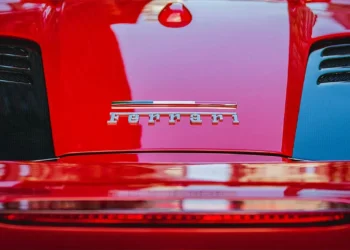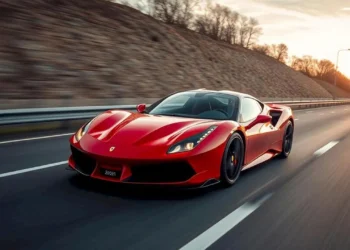McLaren shook the world with the W1 and Porsche got something cooking, big-time. But Ferrari just flipped the script. Again. The F80 isn’t just another hypercar—it’s a road-legal spaceship, rewriting rules nobody even thought to question. It’s been ten years since LaFerrari, and this is what happens when Maranello decides to throw a grenade into the status quo. Think back to the lineage, from the groundbreaking F430 to the more recent F8 Tributo, each a leap forward. But the Ferrari F80 supercar? This is a quantum jump.
A Different Breed of Beast
Ferrari didn’t just think outside the box. They torched the box, buried the ashes, and built something ridiculous. Out goes the traditional, howling V-12. In comes a hybrid 3.0-liter twin-turbo V-6, punched straight from Formula 1. A 120-degree layout. 9,200 rpm redline. Just that engine alone is a fire-breathing 900 Ferrari horsepower monster. But Ferrari wasn’t done. Slap on three electric motors—two up front, one in the back—and suddenly, you’re staring at 1,184 horsepower. That’s not a car. That’s a controlled explosion on four wheels.
Numbers That’ll Melt Your Brain
- 0-62 MPH: 2.15 seconds
- 0-124 MPH: 5.75 seconds
- Top Speed: 217.5 MPH (electronically limited)
- Total Downforce: 2,315 pounds at 155 MPH
- Base Price: €3.6 million ($4 million USD)
- Production Run: Limited to 799 units, arriving in late 2025
Formula 1 DNA, Unleashed on the Streets
Speed? Sure. But Ferrari didn’t just chase numbers; they engineered insanity. The F80’s rear wing deploys itself at 37 MPH, because why not. But it’s not just for looks. That thing generates grip levels that could probably hold the car upside down at full tilt. The underbody is sculpted like an F1 racer’s, featuring an active rear diffuser and the famous Ferrari S-Duct. The result is more downforce than legends like the McLaren Senna or Dodge Viper ACR.
But it doesn’t stop there. What about the suspension? Ferrari rang up Multimatic and built a 48-volt active system that said, “Nah” to anti-roll bars. Instead, it adapts in real-time, keeping the F80 glued to reality—even when reality says, “Physics shouldn’t allow this.” Whether hugging corners or screaming down a straight, this car is as stable as it is unhinged.
Cockpit: Built for the Brave
Inside, distractions don’t exist. The driver’s seat is adjustable. The passenger seat isn’t so much. Why? Because this car isn’t about passengers. It’s about the one behind the wheel. Controls lean toward the driver. The steering wheel is flat-top, flat-bottom, race-spec—this is the future of Ferrari interiors.
Tech-wise, it’s loaded. Ferrari’s Boost Optimization system doesn’t just throw power around—it analyzes a track, calculates the best places to unleash electric boost, and shaves seconds off lap times like it’s playing chess. Drive modes are three—Hybrid, Performance, and Qualify. Each one fine-tuned to unleash just the right amount of insanity, depending on the situation. Full-electric mode is not there. This thing is always awake.
Lightweight, Heavy on Engineering
Ferrari basically built the F80 like a fighter jet. The chassis is asymmetrical carbon-fiber monocoque—letting them keep weight low while still allowing an adjustable seat for the driver. Aluminum front and rear subframes. Carbon-fiber roof. Even the wheels are custom-designed, five-spoke carbon-fiber units, because regular wheels just wouldn’t cut it.
Brakes are Brembo’s latest, greatest CCM-R Plus system. Carbon-ceramic discs that are 100% stronger, 300% more thermally efficient. Matched with Michelin Pilot Sport Cup 2 or 2R tires, and it stops as violently as it accelerates.
Future-Proofed for Decades
Ferrari’s thinking long-term. The “Ferrari Forever” program guarantees replacement high-voltage batteries for decades. You don’t just buy an F80. You buy a piece of the future that stays ahead, even years down the line.
The Hypercar Throne is Claimed
Ferrari didn’t build a hypercar. They built the hypercar. A machine that doesn’t just match the McLaren W1 or whatever Porsche’s cooking—it obliterates them. F1 tech. Aerodynamics that laugh at physics. Power that makes reality feel slow. And at €3.6 million, it’s not just expensive. It’s history, written in carbon fiber.
LaFerrari was a legend. The Ferrari F80 supercar? This is the next chapter in the story of Ferrari future cars.










